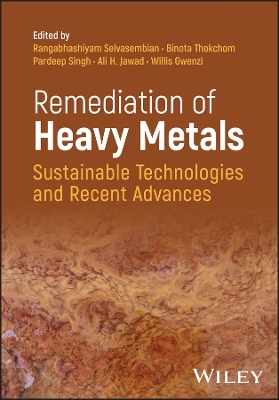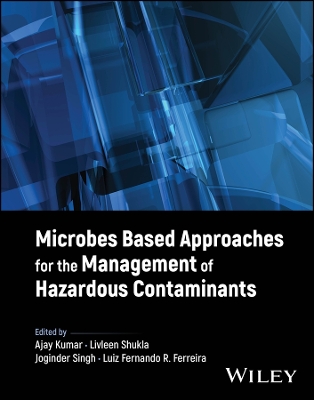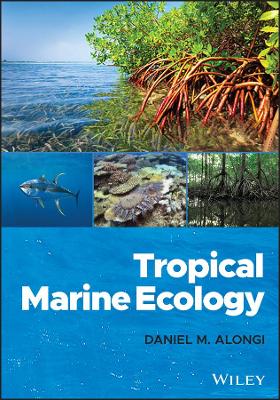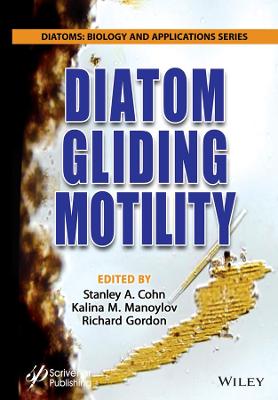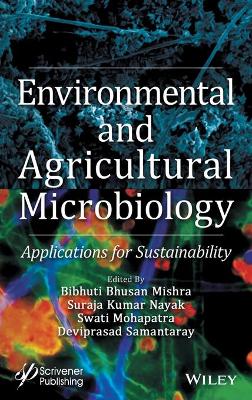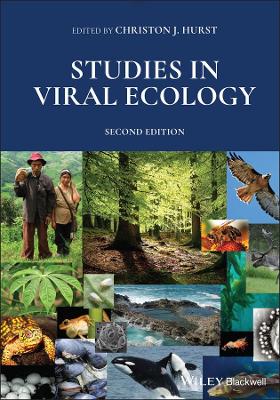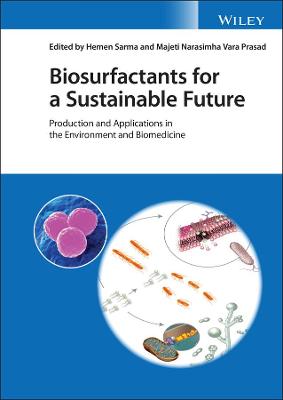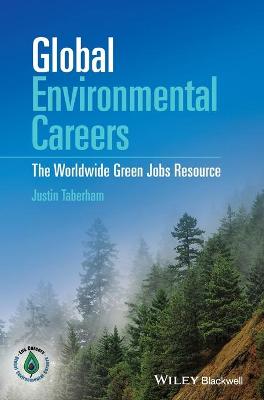Environmental Microbiology and Microbial Ecology
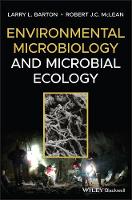 -15%
portes grátis
-15%
portes grátis
Environmental Microbiology and Microbial Ecology
Barton, Larry L.; McLean, Robert J. C.
John Wiley and Sons Ltd
03/2019
464
Dura
Inglês
9781118966266
15 a 20 dias
1130
1 Introduction to Microorganisms and Their Activities 1
1.1 Central Themes of Environmental Microbiology and Microbial Ecology 1
1.2 Are the Terms Prokaryotes or Eukaryotes Relevant? 1
1.2.1 Intracellular Membranes in Prokaryotes 2
1.2.2 Compartmentalized Heterotrophic Bacterial Cells 3
1.2.3 The Universal Tree of Life: Rooted or Unrooted 4
1.2.4 What About the Giant Viruses? 4
1.3 Major Approach to Study Microorganisms 5
1.3.1 Application of Genomics, Metagenomics, and Proteomics 6
1.3.2 Biochemical and Physiological Analysis 7
1.4 The Impact of Horizontal Gene Transfer Between Microorganisms 7
1.4.1 Genetic Islands 9
1.4.2 Risks from Genetically Modified Organisms 10
1.4.3 Microbial Viruses and Gene Transfer Agents 10
1.5 What Determines Which Microorganisms are Present? 12
1.5.1 Metabolism as a Basis of Selection 13
1.5.2 Is Persistence of Microorganisms Dependent Only on Spore Production? 14
1.6 Is the Size and Shape of a Prokaryotic Cell Important? 19
1.6.1 Nanobacteria 19
1.6.2 Ultramicroscopic Bacteria 21
1.6.3 Very Large Bacteria 21
1.6.4 Influence of Diffusion on Bacterial Cell Form 22
1.6.5 Features of a Specific Cell Form 22
1.6.5.1 Coccus Form 22
1.6.5.2 Rod Form 22
1.6.5.3 Curved Rod or Spirochete Form 23
1.6.5.4 Unusual Forms 23
1.7 Microbial Predation 23
1.7.1 Bacteria as Prey 23
1.7.2 Bacteria as Trackers and Predators 24
1.8 Summary 25
Discussion Questions 25
References 26
Further Reading 31
2 Microbes in the Biosphere: Examination, Cultivation, and Communities 33
2.1 Overview and Focus 33
2.2 Microscopy to Study Environmental Microbes 33
2.2.1 Light Supported Microscopy 34
2.2.2 Fluorescence Microscopy 35
2.2.3 Scanning Confocal Laser Microscopy 37
2.2.4 High Resolution by Electron Microscopy 37
2.3 Internal Structures in Prokaryotes 41
2.3.1 Gas Vacuoles 41
2.3.2 Sulfur Globules 41
2.3.3 Polymeric Carbon Reserves 42
2.3.4 Polyphosphate Granules 43
2.3.5 Metallic Nanoparticles 43
2.4 Strategies for Culturing Microorganisms 44
2.4.1 Overview 44
2.4.2 Approaches for Isolation of Microorganisms 45
2.4.3 Establishing Microbial Communities 45
2.4.4 The iChip and Growing Uncultured Bacteria 46
2.5 Molecular Detection 49
2.5.1 Characterization of Microorganisms Using Genomics and Metagenomics 49
2.5.2 Physiological Analysis Using Metatranscriptomics and Metaproteomics 53
2.5.3 Lipid Biomarker Profiles 54
2.6 Examining Bacteria that Do Not Grow as Pure Cultures in the Laboratory 56
2.6.1 Host-dependent Microorganisms 56
2.6.1.1 Bacteria as Obligate Pathogens 56
2.6.1.2 Bacteria as Endosymbionts 57
2.6.1.3 The Nanoarchaeum-Ignicoccus Relationship 58
2.6.2 Molecular Analysis of Uncultivable Bacteria 58
2.7 Microbial Community Structures 59
2.7.1 Primary Production and Microbial Communities 59
2.7.2 Biofilms 62
2.7.3 Role of Quorum Sensing 64
2.8 Summary 67
Discussion Questions 68
References 68
Further Reading 75
3 Terrestrial Systems: Soil and Subsurface Environments 77
3.1 Overview and Focus 77
3.2 Soil: An Environment for Microorganisms 77
3.2.1 Soil Horizons 78
3.2.2 Soil Organic Matter (SOM) 78
3.3 Soil Microbiology 80
3.3.1 Soil Prokaryotes 80
3.3.2 Soil Fungi 82
3.3.3 Soil Crusts 83
3.3.4 Soil Invertebrates and Burrowing Animals 83
3.3.5 The Rhizosphere and Associated Bacteria 83
3.4 Understanding Soil Ecosystems 85
3.4.1 The Carbon : Nitrogen Ratio 85
3.4.2 The Fungi : Bacteria Ratio 85
3.4.3 SOM and Soil Food Webs 86
3.4.4 Influence of Agricultural Management on the Soil Microbe Community 89
3.4.5 Impact of Viruses on the Soil Microbiota 90
3.5 Subsurface Microbiology 90
3.5.1 Groundwater 90
3.5.2 Cave Water 92
3.5.3 Deep Subsurface Aquifers 92
3.5.3.1 Aquifer in a Coal-bearing Basin 92
3.5.3.2 Deep Granitic Aquifer 93
3.5.3.3 Anaerobic, Alkaline Aquifer 94
3.5.3.4 Saline Hydrothermal Aquifer 94
3.6 Deep Subsurface Microbiology 95
3.6.1 Marine Sediment Microbiology 96
3.6.2 Deep Mines and Boreholes 97
3.6.3 Deep Subsea Floor 98
3.6.4 Deep Subsurface Storage Sites 98
3.6.4.1 Storage of Nuclear Fuel Waste 98
3.6.4.2 Underground Storage for H 2 and CH 4 100
3.6.4.3 Underground Storage for CO 2 101
3.6.4.4 Geothermal Energy Production 102
3.6.5 Endolithic Microorganisms 102
3.7 Life in Deep Subsurfaces 103
3.7.1 Adjusting to a Subsurface Diet 103
3.7.2 Energy Sources in the Deep Biosphere 103
3.7.3 The Benefit of Living Together 105
3.8 Geomicrobiology 106
3.8.1 Rock and Mineral Weathering 106
3.8.2 Mineral Transformations 107
3.8.3 Microbial Metal Binding 109
3.8.4 Microbiota of Subsurface Crystals 109
3.9 Summary 110
Discussion Questions 111
References 111
Further Reading 116
4 Aquatic Surface Environments: Freshwater, Marine, and Wastewater 117
4.1 Overview and Focus 117
4.2 Water as Relevant to Microbial Growth 117
4.2.1 Water Activity 118
4.3 Marine Environments and Associated Microbiomes 119
4.3.1 Marine Primary Productivity 120
4.3.2 Marine Heterotrophs 122
4.3.3 Bacterial Symbionts and Marine Hosts 123
4.3.4 Microbial EPSs, Marine Snow, and Marine Gel Particles 125
4.3.5 Brackish Water and Intertidal Zones 127
4.3.6 Coral Reefs 128
4.4 Freshwater Environments and Associated Microbiomes 131
4.4.1 Lakes and Rivers 132
4.4.2 Wetlands 137
4.4.3 The Snow and Glacier Ice Ecosystems 139
4.4.4 Microbiota of Cold and Hot Springs 140
4.4.5 Microbial Mats 142
4.5 Maintaining Populations in Low Nutrient Environments 144
4.6 Aquaculture Wastewater 148
4.7 Hormone Degradation in Fresh Water 149
4.8 Human Activities and Influence on Microbial Ecology 150
4.9 Drinking Water 151
4.10 Municipal Water Treatment 151
4.11 Wastewater Treatment Systems 152
4.11.1 Septic Tanks 152
4.11.2 Municipal Wastewater Treatment 152
4.11.2.1 Primary Treatment 153
4.11.2.2 Secondary Treatment 153
4.12 Alternative Approaches for Wastewater Treatment 154
4.13 Coliforms and Other Indicator Organisms 155
4.14 Viruses in Aquatic Environments: Diversity and Activity 156
4.15 Summary 158
Discussion Questions 159
References 159
Further Reading 166
5 Life in Extreme Environments 167
5.1 Overview 167
5.2 Sampling in Extreme Environments 168
5.3 Extreme Temperature Environments 173
5.3.1 Psychrophiles 174
5.3.2 Thermophiles 176
5.3.2.1 Alpine Environment - Yellowstone National Park 176
5.3.2.2 Hydrothermal Vent Communities 179
5.3.2.3 The Guaymas Basin 180
5.4 Xerophiles 180
5.5 Piezophiles 182
5.6 Acidophiles 183
5.7 Alkaliphiles 187
5.8 Halophiles and Chaophiles 189
5.9 Radioresistant Microorganisms 194
5.10 Membrane Adaptations to Extreme Conditions 195
5.10.1 Low Temperatures 195
5.10.2 High Temperatures 196
5.10.3 pH Extremes: Low and High 196
5.11 Astrobiology 197
5.12 Nutrient Limited Environments 198
5.13 Volcanic Surfaces 200
5.14 Summary 202
Discussion Questions 202
References 202
Further Reading 209
6 Mutualism: Microorganisms and Terrestrial Plants 211
6.1 Overview and Focus 211
6.2 Cyanobacteria and the Chloroplast Ancestor 211
6.3 Lichens: Cyanobacteria/Algae-Fungi Mutualism 217
6.3.1 Distribution and Organization 217
6.3.2 Natural Products of Lichens 219
6.4 Mutualisms with Cyanobacteria as Intracellular or Epiphytic Organisms 220
6.4.1 Bryophytes 220
6.4.2 Mosses 221
6.4.3 Azolla 221
6.4.4 Gunnera 222
6.4.5 Cycads 222
6.4.6 Geosiphon 222
6.4.7 Diatoms 224
6.5 Rhizobia-Legume Symbiosis 224
6.5.1 Bacterial Species Involved 224
6.5.2 Rhizospheric Rhizobia 225
6.5.3 The Root Nodulation Process 226
6.5.4 Nodules on Plant Stems 230
6.6 Frankia and the Non-legume Nitrogen-fixing Nodule 231
6.7 Mycorrhizae 233
6.7.1 Arbuscular Mycorrhizae (AM) 235
6.7.2 Ectomycorrhiza (EcM) 236
6.8 Patterns of Regulation for Plant-Microbe Mutualism 237
6.9 Bacterial-Fungal Interactions 238
6.9.1 Direct Effects 238
6.9.2 Plant Growth-promoting Bacteria 239
6.9.3 Systemic Induction of Plant Immunity 239
6.10 Endophytic Microorganisms 240
6.11 Microbiology of the Phyllosphere 241
6.12 Summary 242
Discussion Questions 243
References 243
Further Reading 247
7 Mutualism: Microorganisms and Animals 249
7.1 Overview and Focus 249
7.2 Building a Microbial Community - The Role of the Host 249
7.2.1 Microbiology and Innate Immunity 249
7.2.2 Microbiology and Adaptive Immunity 250
7.3 Host Models to Study Parasite Relationships 251
7.3.1 Germ-free Animals 251
7.3.2 Caenorhabditis elegans 251
7.3.3 Drosophila melanogaster 252
7.3.4 Galleria mellonella 252
7.4 Digestive Tract Environment 252
7.4.1 Omnivores 253
7.4.2 Carnivores 254
7.4.3 Herbivores 255
7.4.3.1 Bacteria and Archaea 257
7.4.3.2 Anaerobic Protozoa 257
7.4.3.3 Anaerobic Fungi 258
7.4.3.4 Probiotics and Methane Mitigation Strategies 260
7.5 The Human Microbiome 260
7.5.1 Skin 260
7.5.2 Oral Microorganisms 261
7.5.3 Intestinal Microbiome 263
7.5.3.1 Establishment of Intestinal Flora 263
7.5.3.2 The Healthy Gut 264
7.5.3.3 Influence of the Intestine on Human Health 265
7.5.3.4 Obesity, Diabetes, and Health Issues 266
7.5.3.5 Probiotics 269
7.6 Gut Microbiota across the Animal World 269
7.6.1 Systems of Maternal Transmission 270
7.6.2 Microbiota of Ruminates and Hindgut Fermenters 270
7.6.3 Gut Microbiota of Bears 275
7.6.4 Microbiota of Birds 275
7.6.5 Intestinal Bacteria of Fish 278
7.7 Insect-Fungus Symbiosis 279
7.7.1 Scale Insects and Septobasidium 279
7.7.2 Attine Ant-Fungus Symbiosis 279
7.7.3 Woodwasp-Fungus Symbiosis 280
7.7.4 Ambrosia Beetles-Fungus 281
7.7.5 Termite-Fungus 281
7.8 Mutualisms Involving Insects and Bacteria 282
7.8.1 Aphids-Buchnera and Endosymbionts 282
7.8.2 Wolbachia-Insects 283
7.8.3 Mealybug-Bacteria 283
7.8.4 Termite Gut-Bacteria 284
7.9 Mutualisms Involving Invertebrates 285
7.9.1 Microbiome of Marine Worms 285
7.9.2 Squid (Euprymna)-Vibrio fischeri Symbiosis 286
7.9.3 Medicinal Leech-Aeromonas sp. and Rikenella-like Bacteria 287
7.9.4 Nematode-Bacteria 288
7.10 Summary 288
Discussion Questions 289
References 290
Further Reading 295
8 Microbes Driving the Nutrient Cycles 297
8.1 Overview and Focus 297
8.2 Nutrient Cycles and What Drives Them 297
8.3 The Aerobic Environment 299
8.3.1 The "Great Oxidation Event" 299
8.3.2 Oxygen Cycle 300
8.3.3 Hydrogen Peroxide and ROS 303
8.4 Carbon - A Renewable Resource 304
8.4.1 Carbon Dioxide Fixation and Carbonate Reduction 305
8.4.2 Methanogenesis, Methanotrophy, and Methylotrophy 306
8.4.3 Mineralization of Carbon Compounds 308
8.4.4 Production and Utilization of CO 311
8.4.5 Production and Utilization of Hydrogen Cyanide 312
8.5 Nitrogen for Biosynthesis and Energy 312
8.5.1 Nitrification 314
8.5.2 Denitrification 314
8.5.3 Nitrate Reduction 315
8.5.4 Nitrite Reductase 316
8.5.5 Metabolism of NO and N 2 O 316
8.5.6 Production of NO by NOS 317
8.5.7 Respiratory Ammonification 317
8.5.8 Anammox Reaction 318
8.5.9 Assimilation of Nitrogen 318
8.5.10 Dinitrogen Fixation 318
8.6 Sulfur Cycling 319
8.6.1 Oxidation of Hydrogen Sulfide 320
8.6.2 Oxidation of Elemental Sulfur 321
8.6.3 Dissimilative S 0 Reduction 321
8.6.4 Dissimilative Sulfate Reduction 322
8.6.5 Assimilatory Sulfate Reduction 322
8.6.6 Production of H 2 S and Dimethyl Sulfide 322
8.6.6.1 Hydrogen Sulfide 322
8.6.6.2 Dimethyl Sulfide 323
8.7 Cycling of Trace Elements 324
8.7.1 Iron 324
8.7.2 Manganese 326
8.8 Phosphorus Cycling 328
8.9 Selenium Cycling 330
8.10 Cycling Toxic Elements 331
8.10.1 Mercury 331
8.10.2 Arsenic 332
8.11 Summary 335
Discussion Questions 335
References 336
Further Reading 340
9 Bioremediation Using Microorganisms 341
9.1 Overview and Focus 341
9.2 Microbial Bioremediation: Strategies and Applications 341
9.2.1 Biostimulation 343
9.2.2 Bioaugmentation 344
9.2.2.1 Indigenous Bacteria 344
9.2.2.2 Genetically Modified Organisms 344
9.2.3 Intrinsic Bioremediation 345
9.2.4 Microbial Consortium 345
9.2.5 Co-metabolism 346
9.3 Organic Compounds and Xenobiotics Degraded 347
9.3.1 Pesticides 347
9.3.2 Chlorinated Organic Compounds 348
9.3.2.1 Chloroethylenes 349
9.3.2.2 Chloromethanes 350
9.3.2.3 Polychlorinated Biphenyl Compounds 351
9.3.3 Population Dynamics in Degradation of Hydrocarbons 352
9.3.3.1 Oil Spills 352
9.3.3.2 Fuel Hydrocarbons 353
9.3.3.3 Polyaromatic Hydrocarbons 355
9.3.3.4 Azo Dyes 357
9.3.4 Explosives 357
9.3.4.1 Trinitrotoluene 357
9.3.4.2 RDX and HMX 359
9.3.4.3 Perchlorate 359
9.3.5 Bioremediation and Detoxification of Metal(loid)s 359
9.3.5.1 Dissimilatory Metal(loid) Reduction 360
9.3.5.2 Methylation Reactions 361
9.4 Design of Systems for Bioremediation 362
9.4.1 In Situ vs Ex Situ 362
9.4.2 Bioreactors 363
9.4.3 Biofarming 363
9.4.4 Permeable Reactive Barriers 363
9.4.5 Groundwater and Lagoon Treatment 363
9.4.6 Bioventing 364
9.5 Summary 364
Discussion Questions 364
References 365
Further Reading 370
10 Biocorrosion and Geomicrobiology 371
10.1 Overview and Focus 371
10.2 Microbially Influenced Corrosion (MIC) of Ferrous Metals 371
10.2.1 Current Theories of Biocorrosion 371
10.2.1.1 Emic 373
10.2.1.2 Cmic 374
10.2.1.3 Iron Sulfide Crusts 374
10.2.1.4 Biofilms and Extracellular Matrix 374
10.2.2 Biocorrosion of Nonferrous Materials 375
10.2.3 Control of Biocorrosion 376
10.3 Bioalteration of Rocks, Monuments, and Other Surfaces 376
10.3.1 Biofilms on Rocks and Buildings 376
10.3.2 Biodegradation of Art Objects 377
10.3.2.1 Marble Statues in Italy 377
10.3.2.2 Paintings in the Lascaux Cave in France 377
10.3.2.3 Mogao Grottoes in China 378
10.3.2.4 Damage to Frescoes 378
10.3.3 Biotechnology for Restoration of Artworks and Historic Stones 378
10.4 Biodeterioration of Concrete 380
10.5 Mineral Interaction and Biomineralization 382
10.5.1 Iron Hydroxides 382
10.5.2 Magnetic Mineral Crystals 383
10.5.3 Manganese Oxides 383
10.5.4 Carbonates 384
10.5.5 Phosphates 384
10.5.6 Sulfates 385
10.5.7 Sulfides 385
10.5.8 Clays 385
10.5.9 Uranium Precipitate and Crystals 386
10.5.10 Gold Grains 386
10.6 Interactions with Transition and Rare Earth Elements 387
10.6.1 Transition Elements 387
10.6.2 Rare Earth Elements 388
10.7 Toxic Elements 389
10.7.1 Mercury 389
10.7.2 Chromium 389
10.7.3 Arsenic 390
10.7.4 Selenium 390
10.8 Metallic and Metalloid Nanoparticles of Microbial Origin 391
10.9 Summary 393
Discussion Questions 393
References 394
Further Reading 398
11 Microbial Communities and Metabolic Networks 399
11.1 Overview and Focus 399
11.2 Examples of Succession of Populations 399
11.2.1 Development of Coral Black Band Disease 400
11.2.2 Population Succession in Production of Dairy Products 400
11.2.3 Population Dynamics in Fermentation of Non-dairy Foods 401
11.2.3.1 Kimchi 401
11.2.3.2 Coffee 401
11.2.3.3 Cocoa 402
11.2.3.4 Chinese Soy Sauce 402
11.2.4 Composting Plant Material 403
11.3 Impact of Climate Change on Microorganisms 403
11.3.1 Marine Environment 403
11.3.2 Soil Environment 404
11.4 Syntrophy and Co-metabolism 406
11.5 Ecosystem Created by Hydraulic Fracturing in Shale 408
11.6 Extracellular Electron Transport 408
11.6.1 Membrane-bound Proteins 409
11.6.2 Electron Shuttling 409
11.6.3 Nanowires 410
11.6.4 Extracellular Electron Movement in Biofilms 410
11.7 Cross-talk: Interkingdom Signaling 410
11.7.1 Microbial Endocrinology 411
11.7.2 Cross-signaling in Nonhuman Systems 412
11.8 Evolving Systems of Interest 412
11.8.1 Polyploidy in Bacteria 412
11.8.2 Impact of Viruses and CRISPR-cas Systems 414
11.8.3 Impact of Outer Membrane Vesicles 416
11.8.4 Atmospheric Microbiology 420
11.8.5 Long-distance Electron Transfer 423
11.9 Summary 424
Discussion Questions 425
References 425
Further Reading 433
Index 435
1 Introduction to Microorganisms and Their Activities 1
1.1 Central Themes of Environmental Microbiology and Microbial Ecology 1
1.2 Are the Terms Prokaryotes or Eukaryotes Relevant? 1
1.2.1 Intracellular Membranes in Prokaryotes 2
1.2.2 Compartmentalized Heterotrophic Bacterial Cells 3
1.2.3 The Universal Tree of Life: Rooted or Unrooted 4
1.2.4 What About the Giant Viruses? 4
1.3 Major Approach to Study Microorganisms 5
1.3.1 Application of Genomics, Metagenomics, and Proteomics 6
1.3.2 Biochemical and Physiological Analysis 7
1.4 The Impact of Horizontal Gene Transfer Between Microorganisms 7
1.4.1 Genetic Islands 9
1.4.2 Risks from Genetically Modified Organisms 10
1.4.3 Microbial Viruses and Gene Transfer Agents 10
1.5 What Determines Which Microorganisms are Present? 12
1.5.1 Metabolism as a Basis of Selection 13
1.5.2 Is Persistence of Microorganisms Dependent Only on Spore Production? 14
1.6 Is the Size and Shape of a Prokaryotic Cell Important? 19
1.6.1 Nanobacteria 19
1.6.2 Ultramicroscopic Bacteria 21
1.6.3 Very Large Bacteria 21
1.6.4 Influence of Diffusion on Bacterial Cell Form 22
1.6.5 Features of a Specific Cell Form 22
1.6.5.1 Coccus Form 22
1.6.5.2 Rod Form 22
1.6.5.3 Curved Rod or Spirochete Form 23
1.6.5.4 Unusual Forms 23
1.7 Microbial Predation 23
1.7.1 Bacteria as Prey 23
1.7.2 Bacteria as Trackers and Predators 24
1.8 Summary 25
Discussion Questions 25
References 26
Further Reading 31
2 Microbes in the Biosphere: Examination, Cultivation, and Communities 33
2.1 Overview and Focus 33
2.2 Microscopy to Study Environmental Microbes 33
2.2.1 Light Supported Microscopy 34
2.2.2 Fluorescence Microscopy 35
2.2.3 Scanning Confocal Laser Microscopy 37
2.2.4 High Resolution by Electron Microscopy 37
2.3 Internal Structures in Prokaryotes 41
2.3.1 Gas Vacuoles 41
2.3.2 Sulfur Globules 41
2.3.3 Polymeric Carbon Reserves 42
2.3.4 Polyphosphate Granules 43
2.3.5 Metallic Nanoparticles 43
2.4 Strategies for Culturing Microorganisms 44
2.4.1 Overview 44
2.4.2 Approaches for Isolation of Microorganisms 45
2.4.3 Establishing Microbial Communities 45
2.4.4 The iChip and Growing Uncultured Bacteria 46
2.5 Molecular Detection 49
2.5.1 Characterization of Microorganisms Using Genomics and Metagenomics 49
2.5.2 Physiological Analysis Using Metatranscriptomics and Metaproteomics 53
2.5.3 Lipid Biomarker Profiles 54
2.6 Examining Bacteria that Do Not Grow as Pure Cultures in the Laboratory 56
2.6.1 Host-dependent Microorganisms 56
2.6.1.1 Bacteria as Obligate Pathogens 56
2.6.1.2 Bacteria as Endosymbionts 57
2.6.1.3 The Nanoarchaeum-Ignicoccus Relationship 58
2.6.2 Molecular Analysis of Uncultivable Bacteria 58
2.7 Microbial Community Structures 59
2.7.1 Primary Production and Microbial Communities 59
2.7.2 Biofilms 62
2.7.3 Role of Quorum Sensing 64
2.8 Summary 67
Discussion Questions 68
References 68
Further Reading 75
3 Terrestrial Systems: Soil and Subsurface Environments 77
3.1 Overview and Focus 77
3.2 Soil: An Environment for Microorganisms 77
3.2.1 Soil Horizons 78
3.2.2 Soil Organic Matter (SOM) 78
3.3 Soil Microbiology 80
3.3.1 Soil Prokaryotes 80
3.3.2 Soil Fungi 82
3.3.3 Soil Crusts 83
3.3.4 Soil Invertebrates and Burrowing Animals 83
3.3.5 The Rhizosphere and Associated Bacteria 83
3.4 Understanding Soil Ecosystems 85
3.4.1 The Carbon : Nitrogen Ratio 85
3.4.2 The Fungi : Bacteria Ratio 85
3.4.3 SOM and Soil Food Webs 86
3.4.4 Influence of Agricultural Management on the Soil Microbe Community 89
3.4.5 Impact of Viruses on the Soil Microbiota 90
3.5 Subsurface Microbiology 90
3.5.1 Groundwater 90
3.5.2 Cave Water 92
3.5.3 Deep Subsurface Aquifers 92
3.5.3.1 Aquifer in a Coal-bearing Basin 92
3.5.3.2 Deep Granitic Aquifer 93
3.5.3.3 Anaerobic, Alkaline Aquifer 94
3.5.3.4 Saline Hydrothermal Aquifer 94
3.6 Deep Subsurface Microbiology 95
3.6.1 Marine Sediment Microbiology 96
3.6.2 Deep Mines and Boreholes 97
3.6.3 Deep Subsea Floor 98
3.6.4 Deep Subsurface Storage Sites 98
3.6.4.1 Storage of Nuclear Fuel Waste 98
3.6.4.2 Underground Storage for H 2 and CH 4 100
3.6.4.3 Underground Storage for CO 2 101
3.6.4.4 Geothermal Energy Production 102
3.6.5 Endolithic Microorganisms 102
3.7 Life in Deep Subsurfaces 103
3.7.1 Adjusting to a Subsurface Diet 103
3.7.2 Energy Sources in the Deep Biosphere 103
3.7.3 The Benefit of Living Together 105
3.8 Geomicrobiology 106
3.8.1 Rock and Mineral Weathering 106
3.8.2 Mineral Transformations 107
3.8.3 Microbial Metal Binding 109
3.8.4 Microbiota of Subsurface Crystals 109
3.9 Summary 110
Discussion Questions 111
References 111
Further Reading 116
4 Aquatic Surface Environments: Freshwater, Marine, and Wastewater 117
4.1 Overview and Focus 117
4.2 Water as Relevant to Microbial Growth 117
4.2.1 Water Activity 118
4.3 Marine Environments and Associated Microbiomes 119
4.3.1 Marine Primary Productivity 120
4.3.2 Marine Heterotrophs 122
4.3.3 Bacterial Symbionts and Marine Hosts 123
4.3.4 Microbial EPSs, Marine Snow, and Marine Gel Particles 125
4.3.5 Brackish Water and Intertidal Zones 127
4.3.6 Coral Reefs 128
4.4 Freshwater Environments and Associated Microbiomes 131
4.4.1 Lakes and Rivers 132
4.4.2 Wetlands 137
4.4.3 The Snow and Glacier Ice Ecosystems 139
4.4.4 Microbiota of Cold and Hot Springs 140
4.4.5 Microbial Mats 142
4.5 Maintaining Populations in Low Nutrient Environments 144
4.6 Aquaculture Wastewater 148
4.7 Hormone Degradation in Fresh Water 149
4.8 Human Activities and Influence on Microbial Ecology 150
4.9 Drinking Water 151
4.10 Municipal Water Treatment 151
4.11 Wastewater Treatment Systems 152
4.11.1 Septic Tanks 152
4.11.2 Municipal Wastewater Treatment 152
4.11.2.1 Primary Treatment 153
4.11.2.2 Secondary Treatment 153
4.12 Alternative Approaches for Wastewater Treatment 154
4.13 Coliforms and Other Indicator Organisms 155
4.14 Viruses in Aquatic Environments: Diversity and Activity 156
4.15 Summary 158
Discussion Questions 159
References 159
Further Reading 166
5 Life in Extreme Environments 167
5.1 Overview 167
5.2 Sampling in Extreme Environments 168
5.3 Extreme Temperature Environments 173
5.3.1 Psychrophiles 174
5.3.2 Thermophiles 176
5.3.2.1 Alpine Environment - Yellowstone National Park 176
5.3.2.2 Hydrothermal Vent Communities 179
5.3.2.3 The Guaymas Basin 180
5.4 Xerophiles 180
5.5 Piezophiles 182
5.6 Acidophiles 183
5.7 Alkaliphiles 187
5.8 Halophiles and Chaophiles 189
5.9 Radioresistant Microorganisms 194
5.10 Membrane Adaptations to Extreme Conditions 195
5.10.1 Low Temperatures 195
5.10.2 High Temperatures 196
5.10.3 pH Extremes: Low and High 196
5.11 Astrobiology 197
5.12 Nutrient Limited Environments 198
5.13 Volcanic Surfaces 200
5.14 Summary 202
Discussion Questions 202
References 202
Further Reading 209
6 Mutualism: Microorganisms and Terrestrial Plants 211
6.1 Overview and Focus 211
6.2 Cyanobacteria and the Chloroplast Ancestor 211
6.3 Lichens: Cyanobacteria/Algae-Fungi Mutualism 217
6.3.1 Distribution and Organization 217
6.3.2 Natural Products of Lichens 219
6.4 Mutualisms with Cyanobacteria as Intracellular or Epiphytic Organisms 220
6.4.1 Bryophytes 220
6.4.2 Mosses 221
6.4.3 Azolla 221
6.4.4 Gunnera 222
6.4.5 Cycads 222
6.4.6 Geosiphon 222
6.4.7 Diatoms 224
6.5 Rhizobia-Legume Symbiosis 224
6.5.1 Bacterial Species Involved 224
6.5.2 Rhizospheric Rhizobia 225
6.5.3 The Root Nodulation Process 226
6.5.4 Nodules on Plant Stems 230
6.6 Frankia and the Non-legume Nitrogen-fixing Nodule 231
6.7 Mycorrhizae 233
6.7.1 Arbuscular Mycorrhizae (AM) 235
6.7.2 Ectomycorrhiza (EcM) 236
6.8 Patterns of Regulation for Plant-Microbe Mutualism 237
6.9 Bacterial-Fungal Interactions 238
6.9.1 Direct Effects 238
6.9.2 Plant Growth-promoting Bacteria 239
6.9.3 Systemic Induction of Plant Immunity 239
6.10 Endophytic Microorganisms 240
6.11 Microbiology of the Phyllosphere 241
6.12 Summary 242
Discussion Questions 243
References 243
Further Reading 247
7 Mutualism: Microorganisms and Animals 249
7.1 Overview and Focus 249
7.2 Building a Microbial Community - The Role of the Host 249
7.2.1 Microbiology and Innate Immunity 249
7.2.2 Microbiology and Adaptive Immunity 250
7.3 Host Models to Study Parasite Relationships 251
7.3.1 Germ-free Animals 251
7.3.2 Caenorhabditis elegans 251
7.3.3 Drosophila melanogaster 252
7.3.4 Galleria mellonella 252
7.4 Digestive Tract Environment 252
7.4.1 Omnivores 253
7.4.2 Carnivores 254
7.4.3 Herbivores 255
7.4.3.1 Bacteria and Archaea 257
7.4.3.2 Anaerobic Protozoa 257
7.4.3.3 Anaerobic Fungi 258
7.4.3.4 Probiotics and Methane Mitigation Strategies 260
7.5 The Human Microbiome 260
7.5.1 Skin 260
7.5.2 Oral Microorganisms 261
7.5.3 Intestinal Microbiome 263
7.5.3.1 Establishment of Intestinal Flora 263
7.5.3.2 The Healthy Gut 264
7.5.3.3 Influence of the Intestine on Human Health 265
7.5.3.4 Obesity, Diabetes, and Health Issues 266
7.5.3.5 Probiotics 269
7.6 Gut Microbiota across the Animal World 269
7.6.1 Systems of Maternal Transmission 270
7.6.2 Microbiota of Ruminates and Hindgut Fermenters 270
7.6.3 Gut Microbiota of Bears 275
7.6.4 Microbiota of Birds 275
7.6.5 Intestinal Bacteria of Fish 278
7.7 Insect-Fungus Symbiosis 279
7.7.1 Scale Insects and Septobasidium 279
7.7.2 Attine Ant-Fungus Symbiosis 279
7.7.3 Woodwasp-Fungus Symbiosis 280
7.7.4 Ambrosia Beetles-Fungus 281
7.7.5 Termite-Fungus 281
7.8 Mutualisms Involving Insects and Bacteria 282
7.8.1 Aphids-Buchnera and Endosymbionts 282
7.8.2 Wolbachia-Insects 283
7.8.3 Mealybug-Bacteria 283
7.8.4 Termite Gut-Bacteria 284
7.9 Mutualisms Involving Invertebrates 285
7.9.1 Microbiome of Marine Worms 285
7.9.2 Squid (Euprymna)-Vibrio fischeri Symbiosis 286
7.9.3 Medicinal Leech-Aeromonas sp. and Rikenella-like Bacteria 287
7.9.4 Nematode-Bacteria 288
7.10 Summary 288
Discussion Questions 289
References 290
Further Reading 295
8 Microbes Driving the Nutrient Cycles 297
8.1 Overview and Focus 297
8.2 Nutrient Cycles and What Drives Them 297
8.3 The Aerobic Environment 299
8.3.1 The "Great Oxidation Event" 299
8.3.2 Oxygen Cycle 300
8.3.3 Hydrogen Peroxide and ROS 303
8.4 Carbon - A Renewable Resource 304
8.4.1 Carbon Dioxide Fixation and Carbonate Reduction 305
8.4.2 Methanogenesis, Methanotrophy, and Methylotrophy 306
8.4.3 Mineralization of Carbon Compounds 308
8.4.4 Production and Utilization of CO 311
8.4.5 Production and Utilization of Hydrogen Cyanide 312
8.5 Nitrogen for Biosynthesis and Energy 312
8.5.1 Nitrification 314
8.5.2 Denitrification 314
8.5.3 Nitrate Reduction 315
8.5.4 Nitrite Reductase 316
8.5.5 Metabolism of NO and N 2 O 316
8.5.6 Production of NO by NOS 317
8.5.7 Respiratory Ammonification 317
8.5.8 Anammox Reaction 318
8.5.9 Assimilation of Nitrogen 318
8.5.10 Dinitrogen Fixation 318
8.6 Sulfur Cycling 319
8.6.1 Oxidation of Hydrogen Sulfide 320
8.6.2 Oxidation of Elemental Sulfur 321
8.6.3 Dissimilative S 0 Reduction 321
8.6.4 Dissimilative Sulfate Reduction 322
8.6.5 Assimilatory Sulfate Reduction 322
8.6.6 Production of H 2 S and Dimethyl Sulfide 322
8.6.6.1 Hydrogen Sulfide 322
8.6.6.2 Dimethyl Sulfide 323
8.7 Cycling of Trace Elements 324
8.7.1 Iron 324
8.7.2 Manganese 326
8.8 Phosphorus Cycling 328
8.9 Selenium Cycling 330
8.10 Cycling Toxic Elements 331
8.10.1 Mercury 331
8.10.2 Arsenic 332
8.11 Summary 335
Discussion Questions 335
References 336
Further Reading 340
9 Bioremediation Using Microorganisms 341
9.1 Overview and Focus 341
9.2 Microbial Bioremediation: Strategies and Applications 341
9.2.1 Biostimulation 343
9.2.2 Bioaugmentation 344
9.2.2.1 Indigenous Bacteria 344
9.2.2.2 Genetically Modified Organisms 344
9.2.3 Intrinsic Bioremediation 345
9.2.4 Microbial Consortium 345
9.2.5 Co-metabolism 346
9.3 Organic Compounds and Xenobiotics Degraded 347
9.3.1 Pesticides 347
9.3.2 Chlorinated Organic Compounds 348
9.3.2.1 Chloroethylenes 349
9.3.2.2 Chloromethanes 350
9.3.2.3 Polychlorinated Biphenyl Compounds 351
9.3.3 Population Dynamics in Degradation of Hydrocarbons 352
9.3.3.1 Oil Spills 352
9.3.3.2 Fuel Hydrocarbons 353
9.3.3.3 Polyaromatic Hydrocarbons 355
9.3.3.4 Azo Dyes 357
9.3.4 Explosives 357
9.3.4.1 Trinitrotoluene 357
9.3.4.2 RDX and HMX 359
9.3.4.3 Perchlorate 359
9.3.5 Bioremediation and Detoxification of Metal(loid)s 359
9.3.5.1 Dissimilatory Metal(loid) Reduction 360
9.3.5.2 Methylation Reactions 361
9.4 Design of Systems for Bioremediation 362
9.4.1 In Situ vs Ex Situ 362
9.4.2 Bioreactors 363
9.4.3 Biofarming 363
9.4.4 Permeable Reactive Barriers 363
9.4.5 Groundwater and Lagoon Treatment 363
9.4.6 Bioventing 364
9.5 Summary 364
Discussion Questions 364
References 365
Further Reading 370
10 Biocorrosion and Geomicrobiology 371
10.1 Overview and Focus 371
10.2 Microbially Influenced Corrosion (MIC) of Ferrous Metals 371
10.2.1 Current Theories of Biocorrosion 371
10.2.1.1 Emic 373
10.2.1.2 Cmic 374
10.2.1.3 Iron Sulfide Crusts 374
10.2.1.4 Biofilms and Extracellular Matrix 374
10.2.2 Biocorrosion of Nonferrous Materials 375
10.2.3 Control of Biocorrosion 376
10.3 Bioalteration of Rocks, Monuments, and Other Surfaces 376
10.3.1 Biofilms on Rocks and Buildings 376
10.3.2 Biodegradation of Art Objects 377
10.3.2.1 Marble Statues in Italy 377
10.3.2.2 Paintings in the Lascaux Cave in France 377
10.3.2.3 Mogao Grottoes in China 378
10.3.2.4 Damage to Frescoes 378
10.3.3 Biotechnology for Restoration of Artworks and Historic Stones 378
10.4 Biodeterioration of Concrete 380
10.5 Mineral Interaction and Biomineralization 382
10.5.1 Iron Hydroxides 382
10.5.2 Magnetic Mineral Crystals 383
10.5.3 Manganese Oxides 383
10.5.4 Carbonates 384
10.5.5 Phosphates 384
10.5.6 Sulfates 385
10.5.7 Sulfides 385
10.5.8 Clays 385
10.5.9 Uranium Precipitate and Crystals 386
10.5.10 Gold Grains 386
10.6 Interactions with Transition and Rare Earth Elements 387
10.6.1 Transition Elements 387
10.6.2 Rare Earth Elements 388
10.7 Toxic Elements 389
10.7.1 Mercury 389
10.7.2 Chromium 389
10.7.3 Arsenic 390
10.7.4 Selenium 390
10.8 Metallic and Metalloid Nanoparticles of Microbial Origin 391
10.9 Summary 393
Discussion Questions 393
References 394
Further Reading 398
11 Microbial Communities and Metabolic Networks 399
11.1 Overview and Focus 399
11.2 Examples of Succession of Populations 399
11.2.1 Development of Coral Black Band Disease 400
11.2.2 Population Succession in Production of Dairy Products 400
11.2.3 Population Dynamics in Fermentation of Non-dairy Foods 401
11.2.3.1 Kimchi 401
11.2.3.2 Coffee 401
11.2.3.3 Cocoa 402
11.2.3.4 Chinese Soy Sauce 402
11.2.4 Composting Plant Material 403
11.3 Impact of Climate Change on Microorganisms 403
11.3.1 Marine Environment 403
11.3.2 Soil Environment 404
11.4 Syntrophy and Co-metabolism 406
11.5 Ecosystem Created by Hydraulic Fracturing in Shale 408
11.6 Extracellular Electron Transport 408
11.6.1 Membrane-bound Proteins 409
11.6.2 Electron Shuttling 409
11.6.3 Nanowires 410
11.6.4 Extracellular Electron Movement in Biofilms 410
11.7 Cross-talk: Interkingdom Signaling 410
11.7.1 Microbial Endocrinology 411
11.7.2 Cross-signaling in Nonhuman Systems 412
11.8 Evolving Systems of Interest 412
11.8.1 Polyploidy in Bacteria 412
11.8.2 Impact of Viruses and CRISPR-cas Systems 414
11.8.3 Impact of Outer Membrane Vesicles 416
11.8.4 Atmospheric Microbiology 420
11.8.5 Long-distance Electron Transfer 423
11.9 Summary 424
Discussion Questions 425
References 425
Further Reading 433
Index 435

